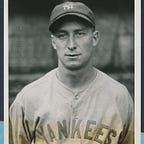Monday Night, July 11, 1927: On the Train from Detroit to Cleveland
Fork Me.
 Schoolboy Hoyt’s failed return to the mound last week in New York lasted all of three pitches before his sore arm gave out.
Schoolboy Hoyt’s failed return to the mound last week in New York lasted all of three pitches before his sore arm gave out.
Today, his start against the Tigers at Navin Field looked like it was heading off the same cliff.
Fastball. Single.
Changeup. Double.
Curveball. Hit batsman.
As Heinie Manush jogs gingerly down to first, having just taken Hoyt’s pitch off his right shoulder, Sailor Bob Shawkey slowly climbs the dugout steps with the intention of coming out to check on Schoolboy.
From the mound Hoyt glares at Shawkey, who goes no farther than the top step.
Two sacrifice flies and a groundout later, Hoyt walks back to the dugout with the rest of the team, having limited the damage to two runs.
Schoolboy drops down on the bench between Benny and me, and grabs his elbow.
“I think I know how the Titanic felt just after it hit the iceberg.”
He closes his eyes, trying to figure out if he can manage the pain — and the Tigers. When he opens them, the first thing he sees is Sailor Bob kneeling in front of him.
“Let’s figure out what’s going on out there,” says Shawkey, sounding like a doctor examining a patient who can’t get out of bed.
“My fastball’s OK, speed-wise, but it has no movement,” says Hoyt. “And my arm hurts too goddamn much for me to throw a curve — I can’t torque it or snap my wrist — it’s too painful to get a decent spin on it. It’s strange, the fade doesn’t hurt so much.”
“He needs another pitch,” says Benny.
“Yeah,” says Hoyt. “Why don’t you go back down to the minors and find one for me.”
“Well,” says Dr. Shawkey, continuing his examination, “you’ve got the bottom third of their lineup comin — ”
Schoolboy cuts off Shawkey, turns to me and asks, “How do you throw your forkball?”
Sailor Bob and I look at each other.
“How do you throw your fork? I’m serious. I need another pitch. Benny’s right.”
“I am?” says Benny.
“Yeah, you are,” says Hoyt. “It was by accident, but you can still count it, if you care about that kind of thing, and I’m guessing you do. But before you write it down in your book, grab me me a ball, will ya’.”
Benny gets up, walks two steps over to where Julie Wera is playing catch with himself, and grabs his ball out of mid-air.
“Here,” Benny says, handing the ball to Schoolboy.
“OK, Tommy,” says Hoyt. “Show me how you hold your forkball.”
“I don’t think this is a great idea,” says Sailor Bob. “Even if you throw the fork right, it can be hard on your elbow, especially if you’ve nev — ”
“Hey,” snaps Schoolboy. “I need a new pitch. Nothing I’ve got here works, and unless I throw something they’re not expecting from me, I’m done today.”
I take the ball from Schoolboy and wedge it deep between my index and middle fingers.
“Grip it with your fingers spread wide around the ball — but not on the seams. You need to wedge it deep enough that the webbing of your hand, all the way till your knuckles, turns white. It should feel uncomfortable.”
Hoyt takes the ball from me and does as instructed. He’s got long, piano player’s fingers, which he’ll need for a shot at controlling the fork.
Sailor Bob cautions him, “You haven’t thrown the pitch before, so keep your thumb in the center of the ball.” Shawkey takes the ball, and shows him how to position his thumb.
“What happens if I move it off the center?” Hoyt asks.
“Well,” says Sailor Bob, “if you keep your thumb centered under the ball, it will look like a fastball without rotation and then drop off the table — with luck just before it gets to the plate and not after.”
“And if I move it?”
“Once you get comfortable throwing the pitch — in a week or two — you can make your thumb act like a rudder to change the direction the ball will break.”
“It’s like this,” I say to him, taking the ball from him. “See how it’s centered? Now, if I move it a smidge to one side or the other, the ball will break not just down but across — if I move my thumb to the right, it’ll break left.”
“What else?” asks Hoyt.
“How much it tumbles depends a lot on the release point. I like to release it a hair later than I release a fastball; that gives it a little more spin and it drops sharper for me.”
On the field, our catcher Pat Collins pops out to end our half of the inning.
“One last thing,” I say to Schoolboy, as he’s putting on his cap to head back out. “The fork isn’t like any other pitch you throw. Don’t let the unexpected shake you — it can have a mind of its own. There’s a mental trick you have to play on yourself — you have to believe you’re in control, even though more often than not the result is going to be something different than you had planned.”
“I think I can manage that,” Schoolboy says with a smile.
“That’s how I live my life.”
 While Pat Collins is putting his gear back on, Benny warms Schoolboy up. Schoolboy’s first pitch is a regular fastball with nothing on it. His next three pitches are forkballs. I’m certain because two of them land in the dirt before they get to the plate, and the third one sails over Benny’s head all the way to the backstop.
While Pat Collins is putting his gear back on, Benny warms Schoolboy up. Schoolboy’s first pitch is a regular fastball with nothing on it. His next three pitches are forkballs. I’m certain because two of them land in the dirt before they get to the plate, and the third one sails over Benny’s head all the way to the backstop.
“This should be really interesting,” says Sailor Bob.
Benny comes back to the dugout and says, “He’s definitely moving his thumb around that ball.”
Schoolboy being Schoolboy, his first real forkball is, of course, perfect. Jackie Tavener, the Tigers’ shortstop is utterly helpless. After swinging over Hoyt’s first offering, he rolls over his next pitch and hits it straight to Lazzeri for an easy out.
“Hey, Sailor Bob!” Urban Shocker says from about 20 feet away, “Did Schoolboy just throw a spitter?”
“Yeah,” Shawkey tells him. “A dry spitter.”
“He forked him!” I shout with glee.
Shocker gets up and walks over to me.
“When did you show him how to throw a forkball?”
“About two minutes ago. In between innings.”
“No, seriously,” says Shocker.
“He’s serious,” says Sailor Bob.
“Well, I’ll be,” Urban mutters to himself.
As Hoyt comes back to the bench after surviving the inning, he has a bemused look on his face.
“I see what you mean about not knowing where that sucker’s going to go,” he says about his new friend, Mr. Forkball.
He sits down between me and Shocker.
“Alright, Shock,” he says. “What have you got in your magic notebooks for me about Warner, Gehringer and Manush — other than their tendency was to hit everything that I threw in the first inning?”
“Warner is much better against righties than lefties — over 100 points better in ’26, and it’s trending that way again in ‘27,” says Shock.
Schoolboy and I look at each other. It’s like Shocker’s married to Ford Frick, the press box mathematician.
“You need to pitch to him like you’re a lefty,” says Sailor Bob. “You’ve now got two pitches that you can start inside and break back across the plate against lefties — fades and forks.”
Shocker continues. “Gehringer hits righties, lefties and everyone in between. Pitchers had success throwing hard and inside against him early in the season, while he was still just a pinch hitter, but he can really cover the plate. He’s quiet, but boy is he good. A bit like Gehrig, actually.”
“And he’s hit safely in 15 of his last 17 games,” chimes in little Eddie Bennett, who’s joined our huddle. “I put that in the book for ya’ last night, Shock.”
“Heinie Manush has been even better,” Shocker says, “hitting well over .400 this month. He’s better against lefties than righties, but he’s crushing them both, especially off-speed pitchers, so if you think you’ve got a fastball left in you, set him up with junk away from the plate and then jam him.”
“Got it,” says Hoyt. “I’ll pitch to Warner like I’m a lefty, Gehringer like I’m his mother, and Manush like it’s still June.”
Ruth pops out to short to end our half of the inning.
“Hey, Shock,” asks Hoyt before he heads back out. “You really pull all of that information about hitters out of old newspapers and box scores?”
“He does. He really does,” chirps little Eddie.
“Most of the time,” says Shocker.
Then Urban says with a smile. “Sometimes, though, I just make it up.”
For the next four innings, Schoolboy keeps the Tigers just enough off balance. He walks more batters than normal, and he’s definitely hittable, but for the Tigers it’s like they’re up against a pitcher they’ve never faced before.
It makes you wonder why more pitchers don’t change their style of pitching more often.
Oh, yeah, it’s because — unlike Schoolboy — they can’t.
In the seventh the Tigers claw Hoyt for a triple and two doubles, and his place on the mound is taken by Sailor Bob.
Hoyt comes back to the dugout to a minor ovation from the bench.
“Fork you,” Hoyt says to me.
“Fork me?” I reply. “Fork you.”
Sailor Bob recorded the game’s final seven outs in relief to close out the game.
Gehrig hit his 29th home run, tying Ruth on the season, as Murderers’ Row hummed along to the tune of eight runs.
Still, despite giving up five runs, four of them earned, over six and two-thirds innings, the best player on the field today was Schoolboy.
I’ve done a lot of thinking about it, and in a tight spot, in a big game, there’s no pitcher living or dead I’d rather have on the mound than Waite Hoyt.
Walter Johnson could throw harder than any man who’s ever picked up a baseball; Christy Mathewson carried the Giants and all of New York City on his shoulders; Old Hoss Radbourn won 60 games in a season; Cy Young won over 500 games in his career; and Pete Alexander might have been better than them all — but if my life depended on one pitcher, for one game, one inning, or one pitch — I’m putting Schoolboy on the mound.
Fork the rest of ‘em.
- Grover Cleveland Alexander
- BENNY Bengough
- EDDIE Bennett
- WAITE Hoyt
- Walter Johnson
- Christy Mathewson
- Old Hoss Radbourn
- SAILOR BOB Shawkey
- URBAN Shocker
- Cy Young
- 1927 Yankees
- July 11, 1927: “Buster Ties Babe In Home-Run Dash”. New York Times article and Box Score.
